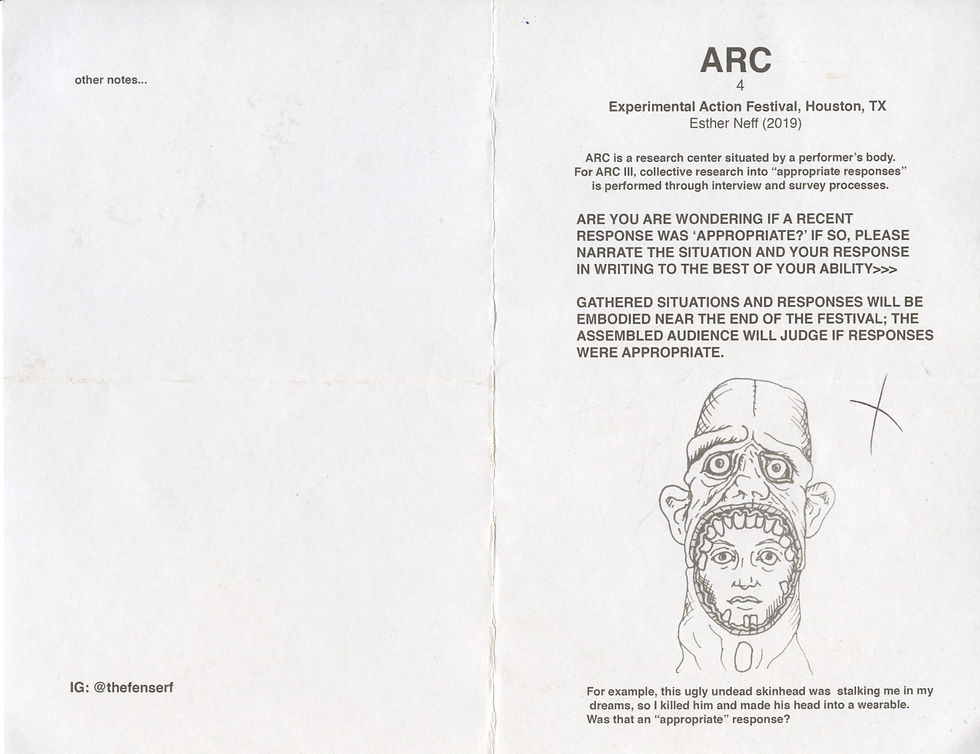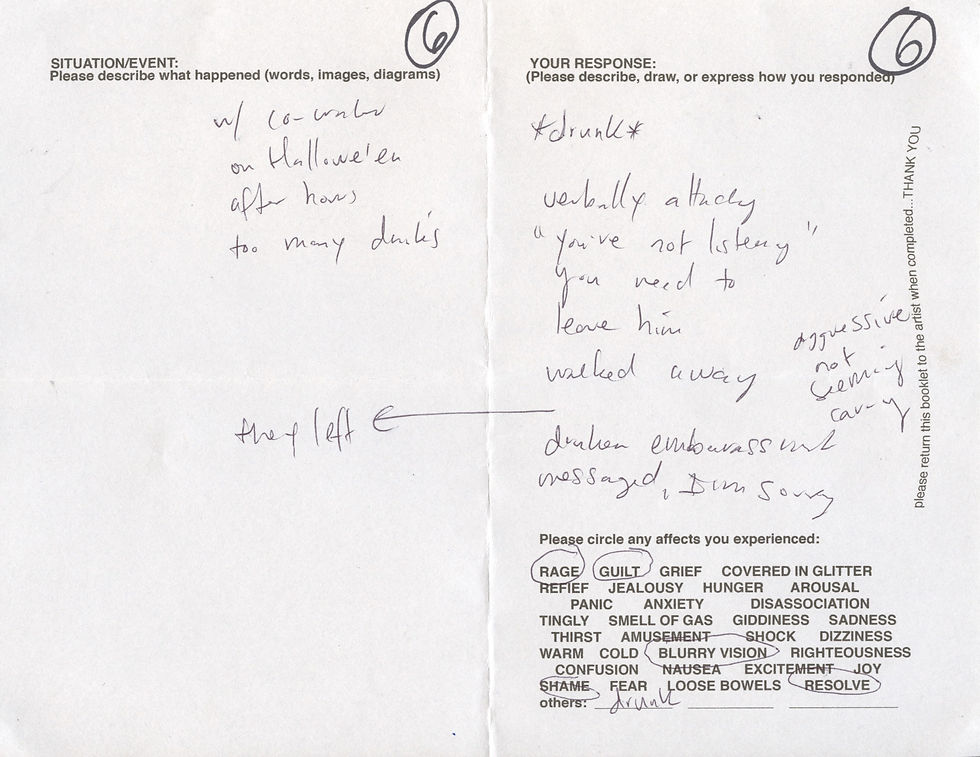Performance Art Review: Esther Neff at Experimental Action
- reema

- Oct 14, 2019
- 4 min read

Saturday night February 23, for the duration of around 45 minutes, at The Secret Group in East Downtown, during the middle of intermission, Esther Neff climbed onto the darkened bar at the back of the performance space and spoke aloud. The crowd had been loitering about, facing the stage opposite the bar, waiting for the next performance to begin. Prior to this, Esther had been seen walking through the crowd, wearing a monster headdress, interviewing audience members and writing down their responses inside grey pamphlets. It took several moments before everyone realized the performance had already begun, and turned to face the bar. Looking up at Esther, a hush fell as people strained to hear. Silently everyone watched as Esther, still speaking, first took off shoes, then basketball shorts, followed by leggings, then the headdress and finally all remaining clothes. The speech crescendoed and decrescendoed as Esther addressed the audience fully nude.
Esther climbed down from the bar, set the pamphlets on the floor, and hunched over, staring at them. In a burst of energy, Esther swiped red solo cups off the bar-top before turning around, picking up the pamphlets, throwing the top one onto the floor and marched into the crowd. Esther gesticulated, roved about in angst for several minutes, then picked up the pamphlets again, and threw the top one onto the floor. This happened several more times, Esther would study the top-most pamphlet, and use locomotor movement and/or vocalizations to perform several actions, then toss a pamphlet onto the floor before studying the next one.

At one point Esther bowed down on the exposed concrete floor as if in prayer, promptly transitioned into a yogi-looking pigeon pose, then lifted up into a lunge before standing and leaving another pamphlet. Next Esther trekked onto the stage, curled up in the far corner as if trying to melt into the walls, lamenting to no one in particular as legs lifted above the head in an upside-down fetal position. A few interactions later, Esther stood in the middle of the floor, face pointed up at the ceiling, laughing intensely. The energy of the room was palpable. After more gesticulations and releasing of pamphlets, Esther descended on hands and knees placing several pamphlets on the floor at audience member’s feet. Esther knelt up, extended arms, wrists exposed, and looked up at a nearby audience member, encouraging them to get down and look at the pamphlets. Other people became curious and gathered to read them. As more people drew close, Esther got up and exited through the crowd, ending the series of mini-performances of people’s responses to the question (in the pamphlet) “Are you wondering if a recent response was ‘appropriate?’”

While writing this article, I found myself more connected with Esther’s work and better able to understand what I’d witnessed. Abstract conceptual and performative arts can be hard to access for me, even though I’m a fine arts graduate student. However, with time and reflection however, the meaning of a work can bubble up to my conscious mind. As Esther reenacted other people’s thoughts and emotions, I sensed a level of absurdity or exaggeration, which profoundly conveyed certain emotions such as depression, anger, fear, but didn’t for others like laughter or excitement. Within each mini-performance, it seemed like the subtleties of emotion was lost, possibly because I was watching from a distance, possibly because it is hard to convey subtleties to a large crowd, possibly because only brash responses are seen as inappropriate, or any other number of reasons. I find this absence of subtlety rather curious and am ruminating on its importance in our responses. Is it culturally more acceptable to have subtle responses? Or are subtleties harder to detect? Or do brazen, brash, bold actions hold our attention better? Is the attention what we’re seeking or what we’re running away from? Another understanding of the work for me was validation. The actions of performative embodiment lent validity to my fears, feelings and insecurities. It put my feelings out in the open, united me with the performer, and somehow connected me to the audience member whose emotions were being conveyed. I felt seen, I felt like I wasn’t so alone, I felt like I had permission to express my feelings out loud because I was witnessing my feelings being expressed by someone else emotionally and physically exposed, vulnerable, and unafraid. It felt like I could have the courage to embody myself more fully without fear or shame. I remember this scene in Harry Potter and the Prisoner of Azkaban, when Harry was asked how he was able to produce a patronus (a complex magical spell above his grade level, that had eluded him all year) and he said something to the effect of: because he’d witnessed his past self doing it, he was able to let go of what was blocking him and actually perform the spell. It is this idea of witnessing ones-self outside of themselves that has provided me with courage to stop holding myself back, to stop worrying about ‘is this appropriate?’ and to just be.




DAFTAR AKUN VIP ACEH4D
DAFTAR AKUN VIP ACEH4D
DAFTAR AKUN VIP ACEH4D
DAFTAR AKUN VIP ACEH4D
DAFTAR SLOT GACOR
DAFTAR SLOT GACOR
DAFTAR SLOT GACOR
LINK ALTERNATIF
LINK ALTERNATIF
LINK ALTERNATIF
DAFTAR ACEH4D
DAFTAR ACEH4D
DAFTAR ACEH4D
DAFTAR ACEH4D
SLOT GACOR
SLOT GACOR
slot gacor
slot toto
slot toto
slot gacor
slot toto
slot toto
slot dana
aceh4d
aceh4d
aceh4d
aceh4d
aceh4d
aceh4d
aceh4d
aceh4d
aceh4d
acehbola
acehbola
acehbola
acehbola
acehbola
acehbola
acehbola
acehbola